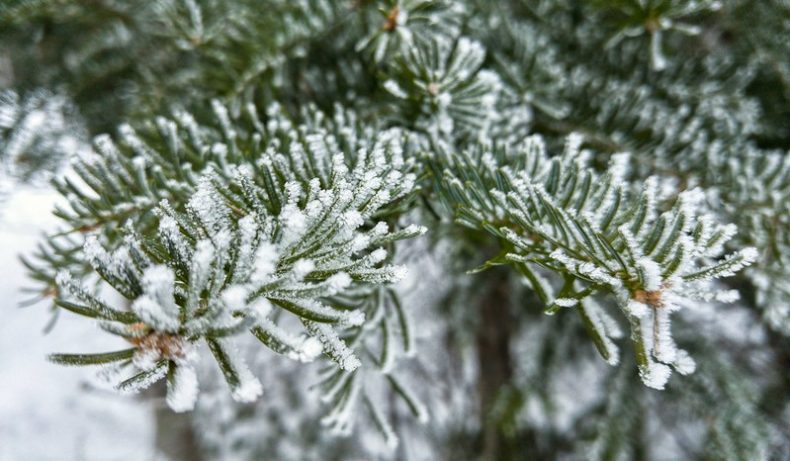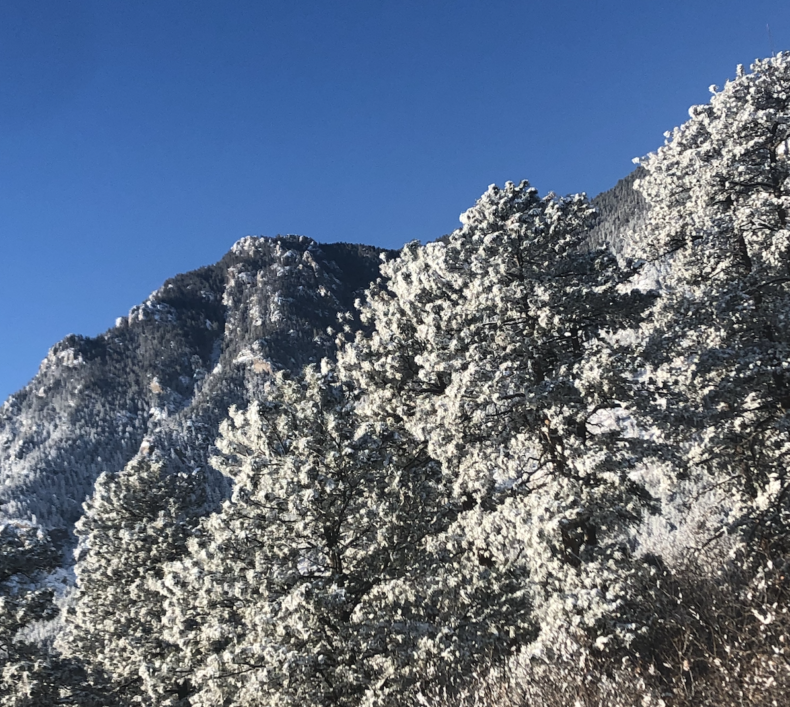
Snow falls often where I live now. I love it, mostly. I do like to work, so I don’t love when it creates snow days. But I love its crisp delicacy, falling soft and softly falling. I love its silence and its brightness. I love the way it tattles on the deer and turkeys and bobcats and coyote and mountain lions and soon, the bears that walk by and around my house.
I especially love the way it falls upon the conifers. The sight of a snow-fattened tiny spruce, or a tall burdened ponderosa, were among the things I missed most during the years I didn’t live in Colorado.
One of my favorite things about living in a pine forest is that after a snowfall, usually in the sunlight of the next morning, you can watch the snow vanishing from the trees. Sometimes this looks like steam, which essentially it is, formed through sublimation (snow turns directly from ice into vapor) in the intense mountain sunlight. Sometimes it looks like the trees are shedding, as snow piles suddenly puff off from upper branches, spilling out in tiny avalanches spurred by breezes or birds. The snow floats off in a little cloud and falls on lower branches, the ground, my dog and I.
I tried to find a scientific term for this, or an explanation for why it happens, and I came across something else instead. We should be concerned with those clouds of vapor and powder. This tree-trapped snow, caught and held by conifer needles and branches, plays an important role in snowpack in the mountains. The Forest Service has been studying it since at least the 1960s.
Snow stops before hitting the ground for five main reasons, according to a 1966 Forest Service research paper: “vapor flux from melt water, vapor flux from bodies of snow, stem flow and dripping of melt water, sliding of bodies of intercepted snow from branches, and wind erosion and transport of intercepted snow.” Sublimation, drips, slips, and wind.

The phenomenon is called interception, describing the way conifers capture and hold snow as it falls. In one study, mature conifer trees were shown to intercept 60 percent of snowfall. Much of that can sublime quickly, meaning it does not trickle down as meltwater, and does not go into the ground or feed streams that the West relies on for water. Even when it doesn’t sublime, the powder clouds I enjoy watching can remove another 30 percent of snowfall. The rest leaves the canopy as meltwater.
“Snow water input” is usually lower right under the tree canopy, which makes sense; of course more snow would fall on a clearing or meadow. But even right on the edges of the canopy, snow water input can be 30 to 40 percent higher than under the canopy directly, according to a 2015 study.
Thick forests can prevent large amounts of snow from ever hitting the ground, in other words, where it would increase water input into the mountains. My snow powderpuffs and sublimation-haze are changing the water cycle I live within.
It will change even more as Earth’s climate changes. But the ways in which this change will manifest are still unclear. It might be better, it might be worse. Wetter snow probably won’t puff as readily. It might just slough off, changing the way mid-branch drifts settle and later melt into tree roots and the water table. Wetter snow is more likely as temperatures warm. An entire (small) branch of physics is focused on understanding how snow crystals form in different temperatures, and how the crystals’ shapes affect their accumulation on surfaces and their melting properties.
If more wet snow sloughs off more quickly, maybe trees will intercept less of it, meaning more of it will reach the ground and soak in. Or, it’s very possible, less snow will fall in the first place. Every year, I watch the Colorado river basin snowpack charts with trepidation. Trees might capture most of what little snow does fall, leaving even less to hit the ground.
Next time it snows, I am going outside to measure. I will do an experiment. The huge ponderosa in my front yard will probably intercept a good amount of the stuff, but I want to find out. I am not worried about my water supply, at least not right now, but I would like to know. And no matter what, I will look at those hazy-sunny mornings, and those powderpuff clouds, a little differently.
–
Photo credits:
Top: Flickr user the real Kam75 (CC BY-SA 2.0)
Bottom: By the author
I was immediately drawn to quite past and more recent recollections of watching the “snow vanishing from the trees” when I read your piece last Friday. I generally regarded the steam as interesting, and pretty much left it at that…never taking the time and mental energy to consider and/or investigate what exactly was happening, and complexity of nature. This morning I was outside early…5:37a Central to be exact…to shovel the snow from my sidewalk before fellow dog-walkers and neighbors trampled the fresh snow into a frozen mess on the pavement. I have a section of yard that passes under large trees (no conifers, unfortunately) and a section where there are no trees (will not get into the details though it involved a speeding car that jumped the curb and narrowly missed our house). The snow in the trees that had started to melt fell as drops, pockmarking the snow underneath. The rest of the snow was still fluffy, a blanket. It makes intuitive sense that the snow under the trees is different than snow in the open. Delving into the science behind that difference is now even more fascinating. Thank you very kindly for your inspiring piece. I look forward to intimately exploring the nature around me.